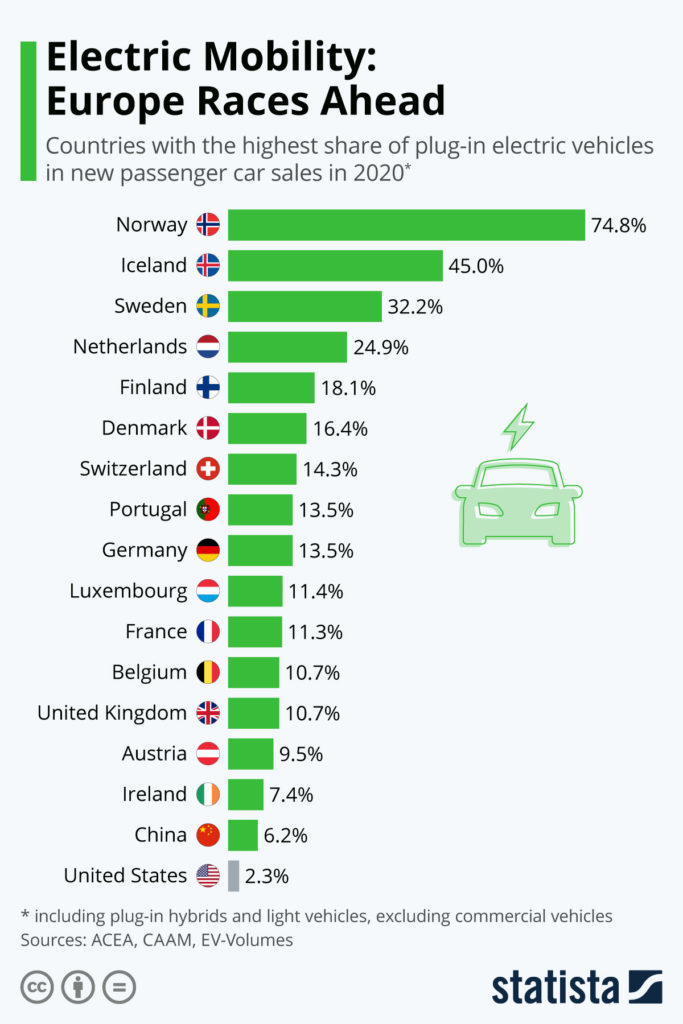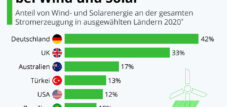Elektromobilität: Europa rast voran
Sprachauswahl 📢
Veröffentlicht am: 10. Mai 2021 / Update vom: 10. Mai 2021 – Verfasser: Konrad Wolfenstein
Elektromobilität: Europa rast voran
Trotz schwieriger Umstände und der negativen Auswirkungen der Pandemie auf die Automobilindustrie haben Elektrofahrzeuge 2020 in vielen Ländern einen großen Sprung nach vorne gemacht. Nach Schätzungen des Industrie-Trackers EV-Volumes machten Plug-in-Elektrofahrzeuge im vergangenen Jahr 4,2 Prozent der weltweiten Light-Vehicle-Verkäufe aus, 2019 waren es noch 2,5 Prozent. Während nur acht Länder im Jahr 2019 einen EV-Anteil von 5 Prozent oder mehr meldeten, schafften es 13 Länder, den Anteil von Elektrofahrzeugen an den Neuwagenverkäufen im Jahr 2020 auf über 10 Prozent zu steigern. Wie in den Vorjahren war Norwegen ein positiver Ausreißer mit einem 75-prozentigen Anteil an Plug-in-Elektrofahrzeugen, während Island, Schweden und Finnland ebenfalls in den Top 5 vertreten waren – ein Beweis für die schnelle Akzeptanz von Elektroautos in den nordischen Ländern. China, der bei weitem größte Markt für Elektroautos in Bezug auf den Absatz, fiel mit einem Anteil von 6,2 Prozent an den Pkw-Verkäufen im Land aus den Top 10 heraus. Währenddessen fielen die Vereinigten Staaten weiter zurück mit einem EV-Anteil von nur 2,3 Prozent.
Während Norwegens politische Maßnahmen (z.B. Steuerbefreiungen, Mautbefreiungen und andere Anreize) sich als sehr effektiv bei der Förderung von Elektroautos erwiesen haben, kann das norwegische Modell nicht einfach auf andere Länder übertragen werden. In erster Linie erhebt das Land hohe Kfz-Importzölle und Zulassungssteuern, die Autos deutlich teurer machen als etwa in den USA. Durch den Verzicht auf diese Zölle für Elektrofahrzeuge subventioniert Norwegen den Kauf von E-Fahrzeugen in einer Höhe, die sich ein größeres Land wie die USA nicht leisten könnte. Zweitens ist Norwegen ein sehr wohlhabendes Land (ironischerweise dank seiner Ölreserven) mit einem hohen Einkommensniveau. Nach Angaben des norwegischen Statistikamtes lag das mittlere Haushaltseinkommen nach Steuern im Jahr 2018 bei 54.000 US-Dollar, was in etwa dem Niveau der USA entspricht, aber mehr als doppelt so hoch ist wie der EU-Durchschnitt.
Electric Mobility: Europe Races Ahead
Despite difficult circumstances and the pandemic’s negative impact on the the automotive industry, electric vehicles made a giant leap forward in many countries in 2020. According to estimates from industry tracker EV-Volumes, plug-in electric vehicles accounted for 4.2 percent of global light vehicle sales last year, up from 2.5 percent in 2019. While just eight countries reported an EV share of 5 percent or higher in 2019, 13 countries managed to push electric vehicles past 10 percent of new light vehicle sales in 2020. Like in prior years, Norway was a positive outlier with a 75-percent share of plug-in electric vehicles, while Iceland, Sweden and Finland also featured in the top 5 – a testament to the quick adoption of electric cars in nordic countries. China, which is by far the largest market for electric cars in terms of unit sales, fell out of the top 10 with electric vehicles accounting for 6.2 percent of passenger car sales in the country. Meanwhile the United States fell further behind with an EV share of just 2.3 percent.
While Norway’s policy measures (e.g. tax exemptions, toll exemptions and other incentives) did prove highly effective in promoting electric cars, the Norwegian model cannot be easily transferred to other countries. First and foremost, the country imposes hefty vehicle import duties and car registration taxes, making cars significantly more expensive than say in the United States. By waiving these duties for electric vehicles, Norway is effectively subsidizing EV purchases at a level that a larger country such as the U.S. couldn’t afford. Secondly, Norway is a very wealthy country (ironically thanks to its oil reserves) with a high level of income. According to Norway’s national statistical institute, the country’s median household income after taxes was around $54,000 in 2018, which is roughly level with the United States but more than twice as high as the EU average.
Passend dazu:
- Elektromobilität: Norwegen rast voraus
- Die Elektromobilität kommt langsam, aber sie kommt
- Ladeinfrastruktur für die Elektromobilität in Deutschland

























